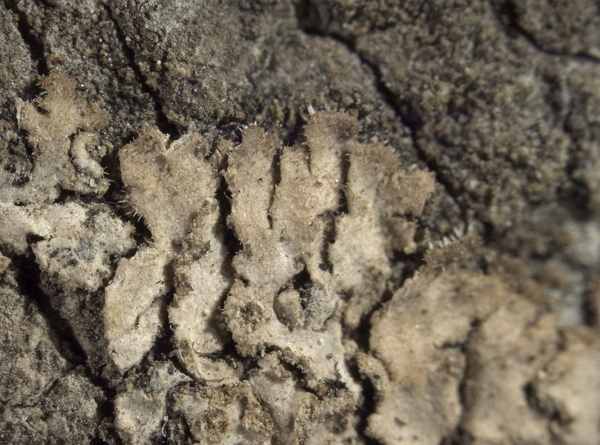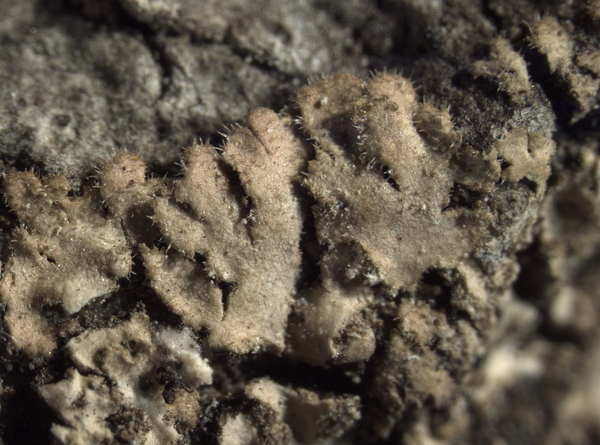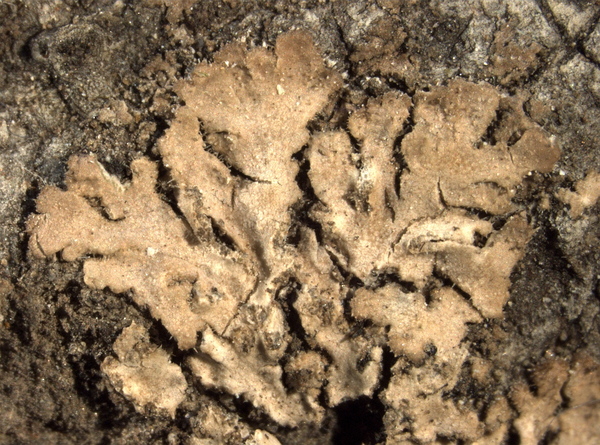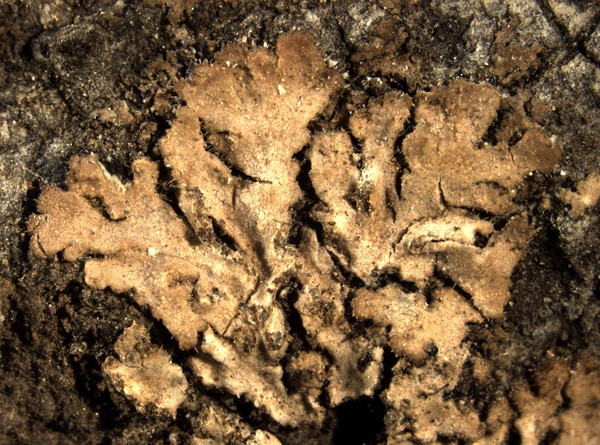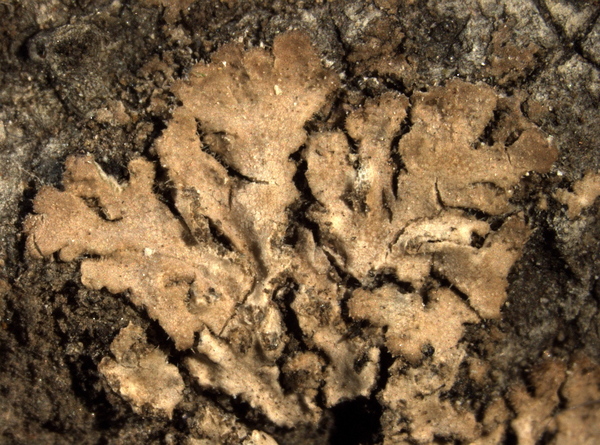Phaeophyscia cernohorskyi (Nádv.) Essl.
Mycotaxon, 7: 294, 1978. Basionym: Physcia cernohorskyi Nádv. - Stud. Bot. Cech., 8: 98, 1947.
Synonyms: Phaeophyscia strigosa (Poelt & Buschardt) N.S. Golubk.; Physcia hirsuta var. echinella Poelt; Physcia setosa var. albociliata B. de Lesd.; Physcia strigosa Poelt & Buschardt
Distribution: N - VG, TAA (Nascimbene & al. 2007b, Zarabska & al. 2009, Ravera & al. 2023b), Lomb, Piem (Clerc & al. 1999), VA (Piervittori & Isocrono 1999), Lig (Valcuvia & al. 2000). C - Tosc (Loppi & al. 1994, 1995, 1997 1998b, Loppi & Frati 2006), Marc, Laz, Abr (Recchia & al. 1993), Sar (Monte 1993). S - Pugl (Nimis & Tretiach 1999), Bas (Puntillo & al. 2012), Si (CLU 8318).
Description: Thallus foliose, heteromerous, dorsiventral, narrow-lobed, irregular to orbicular, up to 3(-4) cm in diam. Lobes discrete to partly imbricate, 0.5-1 mm broad, usually flat, dark grey to dark brown, with sparse to numerous, multicellular cortical hairs near the lobe tips, epruinose, with mainly marginal soralia. Lower surface black, with simple rhizines. Upper and lower cortex paraplectenchymatous; medulla white. Apothecia rare, lecanorine, to 2 mm across, the thalline margin with cortical hairs. Epithecium brown; hymenium and hypothecium colourless; paraphyses slender, often forked in upper part, the apical cells clavate, with a thin dark cap. Asci 8-spored, clavate, the K/I+ blue tholus penetrated by a faintly amyloid apical cushion with parallel or diverging flanks, the wall K/I-, surrounded by a K/I+ blue outer layer, Lecanora-type. Ascospores 1-septate, brown, ellipsoid, 19-26 x 7-13 µm. Pycnidia rare, immersed. Conidia ellipsoid. Photobiont chlorococcoid. Spot tests: K-, C-, KC-, P-, UV-. Chemistry: without lichen substances. Note: a widespread, often misunderstood species, chiefly epilithic in the northern part of its range, but found on a wide variety of substrata in the southern part, with optimum in dry-warm areas. The relationships with P. hirsuta await further study: the latter species is rather frequent throughout submediterranean Italy, whereas P. cernohorskyi is common and abundant only in dry-warm areas, such as in the Alpine dry valleys; several records from Tyrrhenian Italy, especially Tuscany, are therefore dubious.
Growth form: Foliose, narrow lobed
Substrata: bark and rocks
Photobiont: green algae other than Trentepohlia
Reproductive strategy: mainly asexual, by soredia, or soredia-like structures (e.g. blastidia)
Commonnes-rarity: (info)
Alpine belt: absent
Subalpine belt: absent
Oromediterranean belt: absent
Montane belt: extremely rare
Submediterranean belt: very rare
Padanian area: absent
Humid submediterranean belt: very rare
Humid mediterranean belt: very rare
Dry mediterranean belt: extremely rare

Predictive model
Herbarium samples
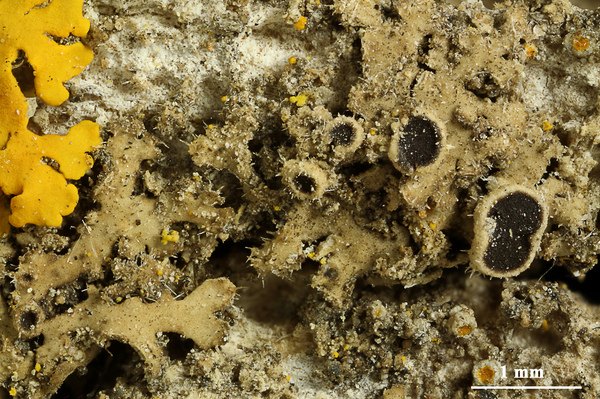

Felix Schumm - CC BY.SA 4.0
[11640], USA, Nebraska, Dawes County: Nebraska National Forest; 18 miles (30 km) SW of Chadron at over-grown picnic area along West Ash Road; 4.5 road miles S of the junction of West Ash Road and Forest Service Road 704; open pine-ash-cottonwood streamside; 42°38’50’’ N, 103°15’53’’ W, 110 m. Leg. S. Morgan & R. Egan, 25. May 2000 Nr. 415.Ex UNIVERSITY OF NEBRASKA AT OMAHA HERB. (OMA)
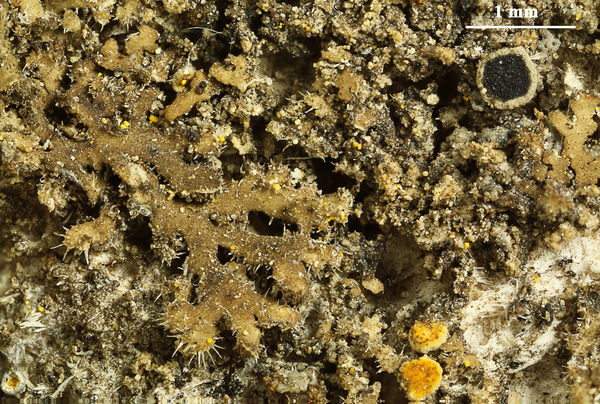

Felix Schumm - CC BY.SA 4.0
[11640], USA, Nebraska, Dawes County: Nebraska National Forest; 18 miles (30 km) SW of Chadron at over-grown picnic area along West Ash Road; 4.5 road miles S of the junction of West Ash Road and Forest Service Road 704; open pine-ash-cottonwood streamside; 42°38’50’’ N, 103°15’53’’ W, 110 m. Leg. S. Morgan & R. Egan, 25. May 2000 Nr. 415.Ex UNIVERSITY OF NEBRASKA AT OMAHA HERB. (OMA)
Growth form: Foliose, narrow lobed
Substrata: bark and rocks
Photobiont: green algae other than Trentepohlia
Reproductive strategy: mainly asexual, by soredia, or soredia-like structures (e.g. blastidia)
Commonnes-rarity: (info)
Alpine belt: absent
Subalpine belt: absent
Oromediterranean belt: absent
Montane belt: extremely rare
Submediterranean belt: very rare
Padanian area: absent
Humid submediterranean belt: very rare
Humid mediterranean belt: very rare
Dry mediterranean belt: extremely rare

Predictive model
| Herbarium samples |


Felix Schumm - CC BY.SA 4.0
[11640], USA, Nebraska, Dawes County: Nebraska National Forest; 18 miles (30 km) SW of Chadron at over-grown picnic area along West Ash Road; 4.5 road miles S of the junction of West Ash Road and Forest Service Road 704; open pine-ash-cottonwood streamside; 42°38’50’’ N, 103°15’53’’ W, 110 m. Leg. S. Morgan & R. Egan, 25. May 2000 Nr. 415.Ex UNIVERSITY OF NEBRASKA AT OMAHA HERB. (OMA)


 Index Fungorum
Index Fungorum
 GBIF
GBIF
